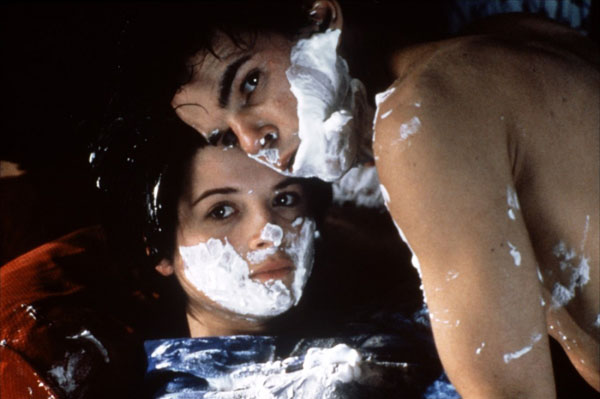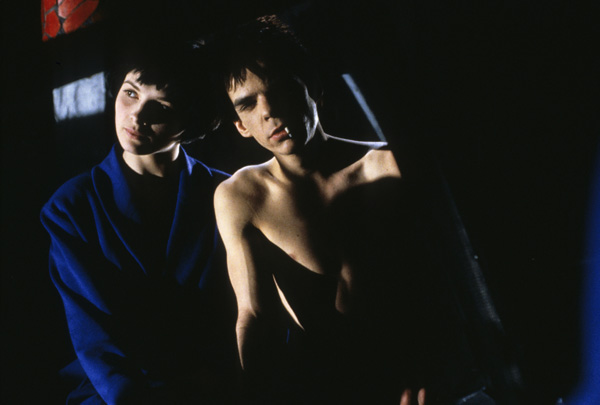A new restoration begins a week-long run at New York’s Film Forum tomorrow, and we begin with Melissa Anderson, writing for the Voice: “Perhaps the most soaring, touching moment in last year’s Holy Motors—a movie steeped in melancholy yet gloriously alive—occurs when Kylie Minogue’s character sings, ‘Who were we/When we were/Who we were/Back then?’ The answer to this question from Leos Carax’s fifth film is discovered while watching his second, Mauvais Sang (1986), a salute, at once moody and ebullient, to the cinema of the past and the ferocious intensity of youth…. Like its predecessor, Boy Meets Girl (1984), Mauvais Sang… is deeply in thrall to the masters of Nouvelle Vague, particularly Jean-Luc Godard. But Carax’s endlessly romantic film transcends homage (and plot, for that matter); above all, his work captures ineffable states of being.”
Dan Sullivan for Film Comment: “In a not-too-distant future, fresh-out-the-joint cardsharp Alex [Denis Lavant] helps his recently deceased career-criminal father’s partners Marc and Hans (Michel Piccoli and Hans Meyer) steal a vaccine for ‘STBO,’ an AIDS-like virus caused by ‘loving without love’ that is ravaging Parisian teenagers from a monolithic, Alphaville-esque max-security high-rise. Ironically nicknamed langue pendue (chatterbox) for his reluctance to speak, Alex is also on the run from his girlfriend Lise (Julie Delpy), whose clingy, obsessive affection overwhelms and repels him…. All too predictably, Alex falls hard for Marc’s much younger girlfriend, Anna [Juliette Binoche], who divides her time between begging Marc for some tenderness and drifting closer to the quiet, short guy who does a ventriloquist act.”
“Film noir fatalism nuzzles in a dark alley with a vaguely dystopian sci-fi vibe,” writes David Fear in Time Out New York. “Murnau-like silent vignettes in scratchy black and white give way to slapstick shaving-cream fights. After watching the former street performer Levant, bursting with romantic fervor, run down to the street and execute a cartwheel with Gene Kelly–worthy grace to ‘Modern Love,’ you will never think of the Bowie song the same way again. (Just ask Noah Baumbach, who paid explicit homage to the scene in Frances Ha.) This is film-drunkenness at its most inebriated.”
Carax, “who once wrote film reviews under the editorship of Serge Daney at Cahiers du Cinéma, has always been something of a chameleon,” writes Kalvin Henely at Slant, “and much like his close collaborator and on-screen alter ego, acrobat-turned-actor Denis Lavant, he possesses an impressive emotional agility that allows him to mimic different sensibilities. Carax and Lavant intuit and pantomime rather than reason and construct, and as such Mauvais Sang sometimes feels irrational and erratic, though never less than rapturous.”
As Melissa Anderson notes further into her review, Lavant is “the writer-director’s acknowledged alter ego,” while Binoche was “Carax’s girlfriend at the time.” Mauvais Sang “exists” for Lavant and Binoche, insists Nicholas Elliott at BOMB, and they appear “here before Lavant looked like a pit bull veteran of a thousand dogfights and Binoche was the figurehead of French prestige. With their black hair and chalk white skin, they look more like twins than lovers. Lavant is an apparition, a beautiful monster with the body proportions of a newborn, a punk Lon Chaney, and the greatest physical actor the cinema has found in several generations.”
John Oursler at the L: “Go to see a cinematic quartet of now-famous artists in their infancy; stay for the exhilarating film they create.”
Suggestions for further reading: “Screen and Surface, Soft and Hard: The Cinema of Leos Carax,” an essay accompanied by a three-part video essay by Cristina Álvarez López and Adrian Martin in Transit; “The Problem with Poetry: Leos Carax,” Jonathan Rosenbaum‘s essay for the May-June 1994 issue of Film Comment; and a two-part “spontaneous” symposium on Holy Motors in LOLA (1 and 2).
Update, 11/29: Charles Taylor for the Los Angeles Review of Books: “We have become so used to the culture of sample and retread, of ironic pomo self-consciousness, that Mauvais sang might be mistaken for one more act of fandom, one more example of scrapbook filmmaking by some boy filmmaker using movie-culture iconography as an emblem of his own cool. Carax doesn’t give a damn about being cool. He works from the inside out, choosing the references he employs for the emotion they can call up rather than the associations they trigger. Carax employs references in the same way that, in his 1960s films, Godard used quotations from literature or cut to advertising graphics in the middle of a film. Rummaging through the work of the masters who have preceded him, Carax searches for the moment that will allow us to sink into the emotion he is reaching for.”
For news and tips throughout the day every day, follow @KeyframeDaily on Twitter and/or the RSS feed. Get Keyframe Daily in your inbox by signing in at fandor.com/daily.





